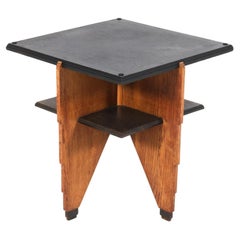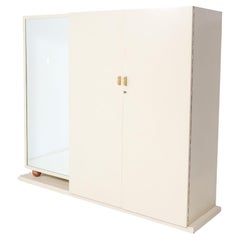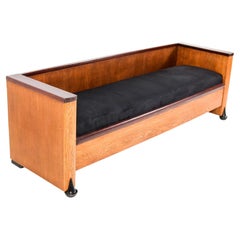Michiel Art Deco
Vintage 1920s Dutch Art Deco Coffee and Cocktail Tables
Glass, Oak
People Also Browsed
Vintage 1930s Dutch Art Deco Wardrobes and Armoires
Brass
Early 20th Century Czech Bauhaus Coffee and Cocktail Tables
Chrome
21st Century and Contemporary German Commodes and Chests of Drawers
Plywood
Vintage 1950s French Mid-Century Modern Wall Lights and Sconces
Metal
Mid-20th Century German Mid-Century Modern Sideboards
Teak
Vintage 1920s Dutch Art Deco Cabinets
Macassar, Oak
2010s American Modern Lounge Chairs
Mohair, Walnut
Vintage 1970s French Modern Ottomans and Poufs
Fabric, Foam
Vintage 1970s Brazilian Mid-Century Modern Armchairs
Velvet, Wood
Vintage 1920s Dutch Art Deco Wall Mirrors
Mirror, Walnut
Vintage 1950s Japanese Mid-Century Modern Lounge Chairs
Wool, Velvet, Oak, Plywood
Vintage 1920s Dutch Art Deco Cabinets
Oak, Hardwood
Vintage 1960s Italian Tables
Wood
Vintage 1960s Italian Mid-Century Modern Picture Frames
Wood
Early 20th Century Dutch Art Deco Armchairs
Velvet, Mahogany
Vintage 1950s French Mid-Century Modern Lounge Chairs
Sheepskin, Oak
Recent Sales
Vintage 1910s Dutch Art Deco Chairs
Faux Leather, Wood, Mahogany
Vintage 1920s Dutch Art Deco Benches
Fabric, Oak
Vintage 1930s Art Deco Figurative Sculptures
Bronze
A Close Look at art-deco Furniture
Art Deco furniture is characterized by its celebration of modern life. More than its emphasis on natural wood grains and focus on traditional craftsmanship, vintage Art Deco dining chairs, tables, desks, cabinets and other furniture — which typically refers to pieces produced during the 1920s and 1930s — is an ode to the glamour of the “Roaring Twenties.”
ORIGINS OF ART DECO FURNITURE DESIGN
- Emerged in the 1920s
- Flourished while the popularity of Art Nouveau declined
- Term derives from 1925’s Exposition Internationale des Arts Décoratifs et Industriels Modernes (International Exhibition of Modern Decorative and Industrial Arts) in Paris, France
- Informed by Ancient Egypt, Cubism, Futurism, Louis XVI, De Stijl, modernism and the Vienna Secession; influenced Streamline Moderne and mid-century modernism
CHARACTERISTICS OF ART DECO FURNITURE DESIGN
- Bold geometric lines and forms, floral motifs
- Use of expensive materials such as shagreen or marble as well as exotic woods such as mahogany, ebony and zebra wood
- Metal accents, shimmering mirrored finishes
- Embellishments made from exotic animal hides, inlays of mother-of-pearl or ivory
ART DECO FURNITURE DESIGNERS TO KNOW
VINTAGE ART DECO FURNITURE ON 1STDIBS
Few design styles are as universally recognized and appreciated as Art Deco. The term alone conjures visions of the Roaring Twenties, Machine Age metropolises, vast ocean liners, sleek typography and Prohibition-era hedonism. The iconic movement made an indelible mark on all fields of design throughout the 1920s and ’30s, celebrating society’s growing industrialization with refined elegance and stunning craftsmanship.
Widely known designers associated with the Art Deco style include Émile-Jacques Ruhlmann, Eileen Gray, Maurice Dufrêne, Paul Follot and Jules Leleu.
The term Art Deco derives from the name of a large decorative arts exhibition held in Paris in 1925. “Art Deco design” is often used broadly, to describe the work of creators in associated or ancillary styles. This is particularly true of American Art Deco, which is also called Streamline Moderne or Machine Age design. (Streamline Moderne, sometimes known as Art Moderne, was a phenomenon largely of the 1930s, post–Art Nouveau.)
Art Deco textile designers employed dazzling floral motifs and vivid colors, and while Art Deco furniture makers respected the dark woods and modern metals with which they worked, they frequently incorporated decorative embellishments such as exotic animal hides as well as veneers in their seating, case pieces, living room sets and bedroom furniture.
From mother-of-pearl inlaid vitrines to chrome aviator chairs, bold and inventive works in the Art Deco style include chaise longues (also known as chaise lounges) and curved armchairs. Today, the style is still favored by interior designers looking to infuse a home with an air of luxury and sophistication.
The vintage Art Deco furniture for sale on 1stDibs includes dressers, coffee tables, decorative objects and more.
- What is art deco jewelry?1 Answer1stDibs ExpertFebruary 22, 2021Art Deco jewelry was popular during the design movement of the 1920s and 30s. Art Deco jewelry is typically characterized by geometric patterns and gemstones of contrasting colors.
- What is an art deco watch?1 Answer1stDibs ExpertApril 5, 2022An art deco watch is defined by its geometric case, which is either circular or rectangular. The watch style was highly popular between 1920 and 1950, and is still sought after today. You’ll find a collection of art deco watches from some of the world’s top sellers on 1stDibs
- What is the history of Art Deco?1 Answer1stDibs ExpertMarch 25, 2024The history of Art Deco begins in the early 20th century.
Art Deco emerged as a global design style around the start of World War I, during the last years of Art Nouveau's popularity. The style conjures visions of the Roaring Twenties, Machine Age metropolises, vast ocean liners, sleek typography and Prohibition-era hedonism. Its hallmarks include the use of geometric designs influenced by Cubism. Major discoveries of Egyptian tombs during the era also influenced the movement.
The term Art Deco derives from the name of a large decorative arts exhibition, the Exposition Internationale des Arts Décoratifs et Industriels Modernes, held in Paris in 1925. After World War II, tastes shifted toward more functional, less ornate modernism, but today, the Art Deco style is still favored for its luxurious sophistication. On 1stDibs, shop a large selection of vintage Art Deco furniture. - What defines Art Deco?1 Answer1stDibs ExpertApril 5, 2024A few things define Art Deco. Date is one factor, as the style emerged in the 1920s and remained popular during the 1930s. Art Deco design usually includes bold geometric lines and forms or intricate repeating floral motifs. Designers working in this style tended to use expensive materials, such as shagreen or marble, as well as exotic woods like mahogany, ebony and zebra wood. Furniture often featured metal accents, mirrored finishes and embellishments made from exotic animal hides and inlays of mother-of-pearl or ivory. Shop a wide range of Art Deco furniture on 1stDibs.
- When did Art Deco originate?1 Answer1stDibs ExpertFebruary 1, 2024The Art Deco period originated in France. Its name comes from the title of a large decorative arts exhibition held in Paris in 1925, credited with introducing the style to the world. It was informed by ancient Egypt, Cubism, Futurism, Louis XVI, De Stijl, modernism and the Vienna Secession and went on to influence the Streamline Moderne and mid-century modern movements. Shop a wide range of Art Deco furniture, decorative objects and jewelry on 1stDibs.
- How do I identify Art Deco?1 Answer1stDibs ExpertApril 5, 2022To identify Art Deco, look for the characteristics of the period. Furniture produced at the time is generally lacquered metal with a mirror-like glossy finish. Wooden items should be an exotic wood. Most items feature symmetrical designs, and geometric forms were popular motifs during the period. In addition, Art Deco often shows the influence of Hellenistic, Egyptian and Asian designs. Shop a variety of Art Deco furniture and decorative objects on 1stDibs.
- What is an Art Deco lamp?1 Answer1stDibs ExpertApril 5, 2022An Art Deco lamp is any lamp that’s made in the styles of the Art Deco movement, which was dominant in the 1920s and 1930s. On 1stDibs, you’ll find a collection of Art Deco lamps from some of the world’s top sellers.
- What is art deco ring?1 Answer1stDibs ExpertAugust 17, 2021Art Deco rings were made during the early 20th century. Named for a design movement that originated at a large decorative arts exhibition held in Paris in 1925, Art Deco rings are generally quite geometric, symmetrical and incorporate a variety of gemstones — especially sapphires and emeralds. Find a wide variety of Art Deco rings for sale on 1stDibs.
- What was Art Deco influenced by?1 Answer1stDibs ExpertMay 3, 2024Art Deco was influenced by a number of things. The discovery of ancient tombs around the turn of the century led to a renewed interest in Egyptian furniture and architecture that inspired Art Deco designers. Art Deco was also informed by Cubism, Futurism, Louis XVI style, De Stijl, modernism and the Vienna Secession. Shop a large collection of Art Deco furniture, decorative objects and jewelry on 1stDibs.
- 1stDibs ExpertAugust 15, 2019
The main difference between Art Nouveau and Art Deco is that the former is detailed and ornate, and the latter is sharp and geometrical. When the movement started at the end of the 19th century, Art Nouveau was heavily influenced by nature and the curved lines of flowers. Art Deco, which became popular in the beginning of the 20th century, was inspired by the geometric abstraction of cubism.
- Are Art Deco rings timeless?1 Answer1stDibs ExpertOctober 30, 2023Yes, Art Deco rings are timeless by many people's standards. Inspired by architecture, Art Deco jewelry pieces show off intricate geometric designs that have remained stylish decade after decade. Plus, the most commonly used materials during the Art Deco period, like platinum and 14-karat yellow gold, are classics. Shop a variety of Art Deco rings on 1stDibs.
- What era was Art Deco rings?1 Answer1stDibs ExpertJune 30, 2023Art Deco rings are from the era of the 1920s and 1930s. While Art Deco began to emerge a bit earlier than that, the style truly gained momentum after the end of World War I. Rings from the time period often feature geometric motifs, bold colors and designs that were influenced by Cubism, Futurism and other movements in visual art. Diamonds were exceptionally popular, while accent gems such as sapphires, emeralds and rubies brought vivid color to engagement rings and added sophistication and glamour. On 1stDibs, shop a variety of Art Deco rings.
- What is Art Deco’s time period?1 Answer1stDibs ExpertSeptember 25, 2019
The Art Deco era is 1925 to 1940.
- What does Art Deco ring mean?1 Answer1stDibs ExpertFebruary 17, 2023The term Art Deco ring means a ring produced in the Art Deco style. Most Art Deco jewelry dates back to the 1920s and 30s and features defined lines and geometric motifs. While a lot of Art Deco rings were black and white — the black coming from the use of onyx or black enamel and the white from rock crystal and diamonds — there is plenty of color in jewelry of the era. A perfect accent to diamonds in platinum settings were blue sapphires, emeralds and rubies, and these stones were also used in combination with each other. On 1stDibs, find a variety of Art Deco rings.
- 1stDibs ExpertSeptember 25, 2019
Art Deco is characterized by geometric shapes, bold colors, visual drama and metallic finishes.
- 1stDibs ExpertApril 5, 2022There are a few tell-tale signs you can look for to determine if a ring is from the Art Deco period. The first big sign is if it has a geometric element to it, as this was a big element of all Art Deco designs. Colored stones were also very popular in the period and it’s not uncommon to see sapphires or rubies taking center stage, rather than a diamond. During the Art Deco period, yellow gold was not very common, instead, jewelers crafted pieces of white gold or platinum. Shop a collection of authentic Art Deco jewelry from some of the world’s top boutiques on 1stDibs.
- 1stDibs ExpertSeptember 25, 2019
Among the key Art Deco designers were Tamara de Lempicka, Erté, René Lalique, Le Corbusier, Jean Dunand, Léon Bakst, Émile-Jacques Ruhlmann, Sonia Delaunay, Georges Lepape and Jean Després.
- 1stDibs ExpertMarch 31, 2023The simplest way to make an Art Deco bedroom is to purchase authentic furniture and decorative accents from the 1920s and ‘30s. Top designers from the period include Émile-Jacques Ruhlmann, Eileen Gray, Maurice Dufrêne and Jules Leleu. Pair authentic Art Deco pieces with a bedding set in a colorful, intricate floral print, or dress up the walls with wallpaper in a geometric motif with hints of gold. The iconic Art Deco movement made an indelible mark on all fields of design throughout the 1920s and ’30s, celebrating society’s growing industrialization with refined elegance and stunning craftsmanship. Find a selection of Art Deco furniture and decor from some of the world's top sellers on 1stDibs.
- 1stDibs ExpertFebruary 1, 2024The years between 1920 and 1939 are generally considered to be the age of Art Deco. However, the name of the movement didn't arrive until 1925, when the Exposition Internationale des Arts Décoratifs et Industriels Modernes in Paris, France, introduced Art Deco design to the world. After the 1930s, Art Deco continued to have an impact, influencing the Streamline Moderne and mid-century modern styles. On 1stDibs, explore a large selection of Art Deco jewelry, furniture and decorative objects.
- 1stDibs ExpertFebruary 27, 2024In its time, Art Deco went out of style due to shifts in trends. After World War II, designers became more interested in modernism and creating pieces with an emphasis on function and simplicity, a move away from the embellishment and adornment that characterized the Art Deco style. It's important to note that Art Deco never fully disappeared. In fact, many present-day collectors have a passion for pieces produced during the 1920s and ’30s. Shop a large selection of Art Deco furniture on 1stDibs.
Read More
Eileen Gray’s Famed Cliffside Villa in the South of France Is Returned to Its Modernist Glory
After years of diligent restoration, E-1027, the designer-cum-architect’s marriage of romance and modernism, is finally complete.
A 1920s Art Deco Necklace with a Stunning Drop Emerald
The cabochon gem centerpiece and diamond-set elliptical rings makes it a marvel of Gatsby-era glamour.
Cartier: The Jeweler Who Helped Define Art Deco
Cartier created some of the most iconic jewelry designs that defined this era.
Our Guide to Victorian, Edwardian and Art Deco Engagement Rings
Learn about these antique jewelry styles, then choose a design that speaks to you.
Why Vintage Watches Are Making a Comeback
Men, women and the watchmakers themselves are falling for the old-fashioned charm of retro timepieces.
The Process: 5 Creators of Chic Customizable Lighting
Bespoke lighting is a hallmark of upscale interiors, and contemporary makers are increasingly ambitious in their materials and forms.
An Incomparable Trove of Art Deco Treasures Is on View in Miami Beach
Heading to Florida for the art and design fairs in early December? Make time on your schedule to visit a newly opened exhibition that examines the movement's migration from Europe to America, and its evolution from niche to universal appeal.
Experts Talk Engagement Ring Trends and Shopping Tips
Ready to rock? Some of our favorite jewelry designers and dealers share indispensable advice for choosing that most important ring.




